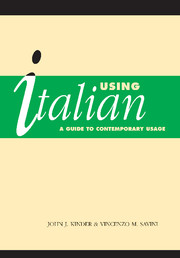Book contents
- Frontmatter
- Contents
- Preface and acknowledgments
- Abbreviations
- 1 Varieties of language
- WORDS AND THEIR MEANINGS
- THE CLAUSE – combining words
- THE SENTENCE – combining clauses
- 25 Italian prepositions
- 26 English prepositions
- 27 Prepositional constructions with verbs and adjectives
- 28 Use of tenses
- 29 Sequence of tenses
- 30 The Subjunctive
- 31 Conditional sentences
- 32 Subordinate clauses
- TEXTS AND THEIR STRUCTURE
- Bibliography
- Italian word index
- Grammar index
30 - The Subjunctive
Published online by Cambridge University Press: 05 June 2012
- Frontmatter
- Contents
- Preface and acknowledgments
- Abbreviations
- 1 Varieties of language
- WORDS AND THEIR MEANINGS
- THE CLAUSE – combining words
- THE SENTENCE – combining clauses
- 25 Italian prepositions
- 26 English prepositions
- 27 Prepositional constructions with verbs and adjectives
- 28 Use of tenses
- 29 Sequence of tenses
- 30 The Subjunctive
- 31 Conditional sentences
- 32 Subordinate clauses
- TEXTS AND THEIR STRUCTURE
- Bibliography
- Italian word index
- Grammar index
Summary
The Subjunctive mood is alive and well in contemporary Italian. Although in R1 and casual conversation it is often replaced by the Indicative, in more formal styles it is often compulsory (and its imperfect tense endings are very distinctive), and it must be mastered by the student at an advanced level. It appears to be used somewhat more in the North than in the South.
The Subjunctive appears both in subordinate clauses (as its English name suggests, though in Italian it is congiuntivo) and also in main clauses of many different types. In some cases the Subjunctive is compulsory and thus conveys no extra meaning in the sentence, while in others, the Subjunctive and Indicative express different meanings. In many other cases, both moods are possible and the difference between them is one of nuance or register.
It is impossible to give a definition of the Subjunctive that covers all its various uses. However, there are some features that account for the majority of uses and will help the student acquire a more confident mastery of this mood. The Subjunctive is, in many ways, the opposite or complement of the Indicative mood. Verbs in the Indicative usually make statements and denials and ask questions about matters that are assumed to relate to the world of reality. Verbs in the Subjunctive, on the other hand, may refer to exactly the same events or facts but not to these events or facts in themselves.
- Type
- Chapter
- Information
- Using ItalianA Guide to Contemporary Usage, pp. 402 - 415Publisher: Cambridge University PressPrint publication year: 2004



